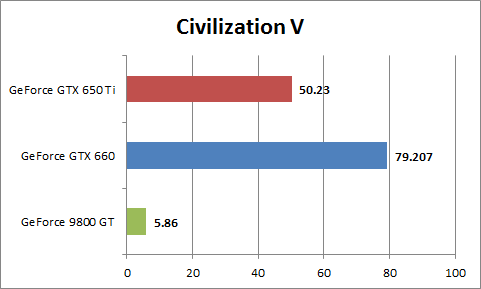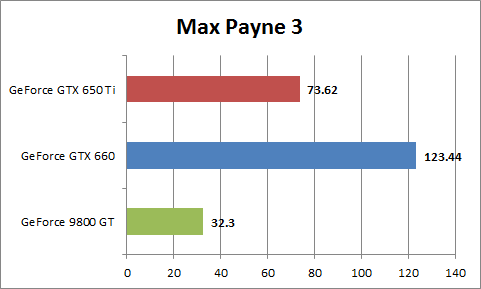
NVIDIA GeForce GTX 650 Ti
Written by John Yan on 10/9/2012 for
PC
PSP
Wii
More On:
GeForce GTX 650 Ti
It’s been a good year for NVIDIA and their Kepler line of video cards. Coming out of the gate with the GeForce GTX 680, they’ve been steadily releasing cards in the line at various price points. Well today, they have their last release of the year and it’s an entry level card for those that don’t want to spend too much, but play the current crop of games (and some future games) with some of the nifty NVIDIA specific features and at a nice resolution.

The GeForce GTX 650 Ti’s coming in at $149, which puts it in the category of damn, that’s a hella affordable card. But to make things even better for a limited time, certain vendors are including a free copy of Assassin’s Creed III, so that sort of takes the card down to $89 if you were going to pick up the game anyways. That’s really inexpensive for a DirectX 11 capable card that can run games at 1080P with some settings adjusted.
We’ve done a few cards so I’m not going to go into what you get with Kepler. Specification wise, here’s what you are going to get:

There’s 1GB of memory onboard, but 2GB versions will be available as well should you so desire.
Physically, the card is pretty short and only needs one six pin power connector to get it to run. TDP on the card is 110W, but NVIDIA has stated that typical gaming uses 80W so there’s some room there to play with.
On the bracket are three connectors: two Dual-Link DVI and one HDMI, but this is a reference card from NVIDIA and you should see some cards with an additional DisplayPort connector as it does support up to four simultaneous outputs.
 It’s lacking an SLI connector so don’t expect to pair two of these up. That’s just not going to happen. There’s also a lack of GPU boost so what you see is what you get in terms of speed. But, NVIDIA said there’s plenty of headroom for some overclocking so you’ll probably be able to eek out some performance enhancements by pushing the card further and some board vendors will be releasing overclocked boards for those that want the warranty with the increased speed.
It’s lacking an SLI connector so don’t expect to pair two of these up. That’s just not going to happen. There’s also a lack of GPU boost so what you see is what you get in terms of speed. But, NVIDIA said there’s plenty of headroom for some overclocking so you’ll probably be able to eek out some performance enhancements by pushing the card further and some board vendors will be releasing overclocked boards for those that want the warranty with the increased speed.
NVIDIA is saying they are up to 20% faster than the competing AMD Radeon HD 7770. We don’t have any AMD cards to test against, so I’m going to run a comparison with some NVIDIA cards. On hand, I have the recently released GeForce GTX 660 which is another affordable Kepler card and the GeForce 9800 GT, which is still a popular card today based on Steam’s hardware survey.
My test system consists of:
Intel i7-2600K processor
12GB of RAM
Gigabyte GA-Z68X-UD3H-B3 motherboard
128GB Crucial M4 SSD drive
Windows 7 w/ Service Pack 1 installed
NVIDIA 306.23 drivers for the 9800GT and GF GTX 660
NVIDIA 306.38 drivers for the GF GTX 650 Ti
I’m going to run through various types of games from fighting to action to strategy, just to give a broad scope of titles. I’ve also thrown a synthetic benchmark in there for those interested in Unigen Heaven and 3D Mark 11. All tests were run at least three times and then an average was taken and displayed in the graph below. For those without a benchmark, I used FRAPS to capture the frames per second. If you're interested to see what I had in my settings for some of the games, they are included in the screenshots at the end of the article.
For 3D Mark 11, I just ran the benchmarking portion on performance setting which has it at 1920x1080. Only the GeForce GTX 660 was ran as the 9800 GT doesn’t support DirectX 11. The GeForce GTX 660 scored a X2307 while the GeForce GTX 650 Ti got a score of X1451.





Sid Meier’s Civilization V - Here I also used the built in benchmark and used FRAPS as well to get an average FPS. I selected the DX10/DX11 version.




The Elder Scrolls V: Skyrim - In Riften, I ran around the area taking the same path each time I tested while using FRAPS to benchmark the game.


For the PhysX test on Batman: Arkham City, I ran the built in benchmark with and without medium PhysX on.
For a very inexpensive card, the GeForce GTX 650 Ti held up nicely in some tests and offered up very playable performance at 1920x1080. All the games did pretty well relatively speaking and the price makes it an attractive upgrade for those with integrated graphics only on their motherboard and don’t want to spend too much adding in a card or those upgrading an older entry level card.
With an older game like Batman: Arkham City, you can even turn on a little PhysX and still get pretty good frame rates. I wouldn’t recommend pushing the PhysX higher though, but you can have some on it seems in some games and get the improved graphical effects that comes with the feature enabled.
Another area where this might be of use is in media centers where you might want to play a game or two on the big screen. Nowadays, the integrated graphics run 1080P video pretty well so the call for discrete graphics cards to help with video playback isn’t as needed as a say a year or two ago, but if you want a quiet, small card that’ll let you play some games with your HTPC, then the GeForce GTX 650 Ti is a good bet without breaking the bank.
With the release of the GeForce GTX 650 Ti, this completes the lineup of Kepler cards from top to bottom. It’s a solid card if you want an entry into DirectX 11 gaming and don’t want to spend too much initially. With the Assassin’s Creed III deal, it’s even more of a steal, but again that’s a for a limited time. It’s been quite a year for Kepler and the GeForce GTX 650 Ti rounds out a solid year for NVIDIA and what they have to offer in the graphics card department.

The GeForce GTX 650 Ti’s coming in at $149, which puts it in the category of damn, that’s a hella affordable card. But to make things even better for a limited time, certain vendors are including a free copy of Assassin’s Creed III, so that sort of takes the card down to $89 if you were going to pick up the game anyways. That’s really inexpensive for a DirectX 11 capable card that can run games at 1080P with some settings adjusted.
We’ve done a few cards so I’m not going to go into what you get with Kepler. Specification wise, here’s what you are going to get:

There’s 1GB of memory onboard, but 2GB versions will be available as well should you so desire.
Physically, the card is pretty short and only needs one six pin power connector to get it to run. TDP on the card is 110W, but NVIDIA has stated that typical gaming uses 80W so there’s some room there to play with.
On the bracket are three connectors: two Dual-Link DVI and one HDMI, but this is a reference card from NVIDIA and you should see some cards with an additional DisplayPort connector as it does support up to four simultaneous outputs.

NVIDIA is saying they are up to 20% faster than the competing AMD Radeon HD 7770. We don’t have any AMD cards to test against, so I’m going to run a comparison with some NVIDIA cards. On hand, I have the recently released GeForce GTX 660 which is another affordable Kepler card and the GeForce 9800 GT, which is still a popular card today based on Steam’s hardware survey.
My test system consists of:
Intel i7-2600K processor
12GB of RAM
Gigabyte GA-Z68X-UD3H-B3 motherboard
128GB Crucial M4 SSD drive
Windows 7 w/ Service Pack 1 installed
NVIDIA 306.23 drivers for the 9800GT and GF GTX 660
NVIDIA 306.38 drivers for the GF GTX 650 Ti
I’m going to run through various types of games from fighting to action to strategy, just to give a broad scope of titles. I’ve also thrown a synthetic benchmark in there for those interested in Unigen Heaven and 3D Mark 11. All tests were run at least three times and then an average was taken and displayed in the graph below. For those without a benchmark, I used FRAPS to capture the frames per second. If you're interested to see what I had in my settings for some of the games, they are included in the screenshots at the end of the article.
For 3D Mark 11, I just ran the benchmarking portion on performance setting which has it at 1920x1080. Only the GeForce GTX 660 was ran as the 9800 GT doesn’t support DirectX 11. The GeForce GTX 660 scored a X2307 while the GeForce GTX 650 Ti got a score of X1451.



Batman: Arkham City - I used the built in benchmark.

Battlefield III - For Battlefield 3, I ran through the first part of the Uprising mission and used FRAPS to benchmark the game.

Sid Meier’s Civilization V - Here I also used the built in benchmark and used FRAPS as well to get an average FPS. I selected the DX10/DX11 version.

Warhammer 40K: Dawn of War II - Again, I used the built in benchmark.

Diablo III - I ran the very beginning of Act I before going into town as that was one of the few parts of the game that doesn’t change and recorded the results using FRAPS.

Max Payne 3 - I loaded up Chapter III and played through the beginning five minutes while running FRAPS.

The Elder Scrolls V: Skyrim - In Riften, I ran around the area taking the same path each time I tested while using FRAPS to benchmark the game.

Super Street Fighter IV Arcade Edition - I used the built in benchmark.

For the PhysX test on Batman: Arkham City, I ran the built in benchmark with and without medium PhysX on.
For a very inexpensive card, the GeForce GTX 650 Ti held up nicely in some tests and offered up very playable performance at 1920x1080. All the games did pretty well relatively speaking and the price makes it an attractive upgrade for those with integrated graphics only on their motherboard and don’t want to spend too much adding in a card or those upgrading an older entry level card.
With an older game like Batman: Arkham City, you can even turn on a little PhysX and still get pretty good frame rates. I wouldn’t recommend pushing the PhysX higher though, but you can have some on it seems in some games and get the improved graphical effects that comes with the feature enabled.
Another area where this might be of use is in media centers where you might want to play a game or two on the big screen. Nowadays, the integrated graphics run 1080P video pretty well so the call for discrete graphics cards to help with video playback isn’t as needed as a say a year or two ago, but if you want a quiet, small card that’ll let you play some games with your HTPC, then the GeForce GTX 650 Ti is a good bet without breaking the bank.
With the release of the GeForce GTX 650 Ti, this completes the lineup of Kepler cards from top to bottom. It’s a solid card if you want an entry into DirectX 11 gaming and don’t want to spend too much initially. With the Assassin’s Creed III deal, it’s even more of a steal, but again that’s a for a limited time. It’s been quite a year for Kepler and the GeForce GTX 650 Ti rounds out a solid year for NVIDIA and what they have to offer in the graphics card department.
A nice little inexpensive card, it's a nice upgrade for those with older generation cards or just integrated graphics and wanting to do some gaming without breaking the bank.
Rating: 8.5 Very Good
* The product in this article was sent to us by the developer/company.

About Author
I've been reviewing products since 1997 and started out at Gaming Nexus. As one of the original writers, I was tapped to do action games and hardware. Nowadays, I work with a great group of folks on here to bring to you news and reviews on all things PC and consoles.
As for what I enjoy, I love action and survival games. I'm more of a PC gamer now than I used to be, but still enjoy the occasional console fair. Lately, I've been really playing a ton of retro games after building an arcade cabinet for myself and the kids. There's some old games I love to revisit and the cabinet really does a great job at bringing back that nostalgic feeling of going to the arcade.
View Profile







